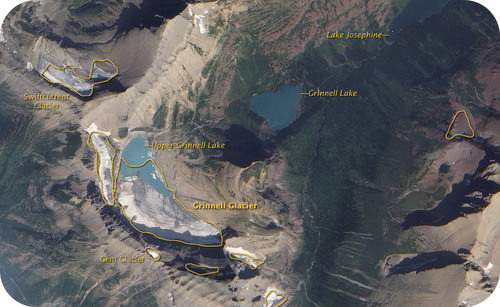8.11冰川
章节大纲
-
Can solid ice really move?
::坚冰真的能移动吗?Yes! This is the Hubbard Glacier in Alaska. As the glacier meets the relatively warm seawater, it calves. Pieces of the glacier break off and fall into the water . These icebergs may be as large as a ten-story building.
::是的,这是阿拉斯加的哈勃冰川。冰川与相对温暖的海水相交,它的小腿。冰川的碎片断裂而掉入水中。这些冰山可能和十层建筑一样大。Where Are The Glaciers?
::冰川人在哪里?Nearly all glacial ice is in the polar regions. The largest ice sheets are in Antarctica and Greenland. The remaining 1% of Earth's ice is found elsewhere, like in the mountains , for example. At higher altitudes , temperatures are colder. Snow is more likely to fall and not melt. Except Australia, every continent has glaciers in the high mountains.
::几乎所有冰川冰都位于极地地区。最大的冰层位于南极洲和格陵兰。地球其余的1%的冰层在其他地方,例如山区。在高地,气温更低。雪层更可能降雪而不是融化。除澳大利亚外,每个大陆都有高山冰川。Types of Glaciers
::冰川种类The types of glaciers are:
::冰川类型如下:- Continental glaciers are large ice sheets that cover relatively flat ground. These glaciers flow outward from where the greatest amounts of snow and ice accumulate.
::大陆冰川是覆盖相对平坦的地面的大型冰原,这些冰川从积雪和冰层最多的地区向外流动。
- Alpine glaciers flow downhill. Ice accumulates near the top of a mountain and then travels down existing valleys ( Figure ).
::高山冰川向下流动。冰在山顶附近积聚,然后沿着现有的山谷(图 ) 。
An alpine glacier in the Swiss Alps. Where do you think the word "alpine" came from? - Ice caps are large glaciers that cover a larger area than just a valley. An ice cap can bury an entire mountain range or region ( Figure ). Glaciers come off of ice caps into valleys.
::冰盖是覆盖面积大于山谷的大冰川。 冰盖可以掩埋整个山脉或地区( 图表 ) 。 冰川会从冰盖中流出进入山谷。
The continent of Antarctica is covered with an ice cap. Glacial Growth
::冰川增长Glaciers are not static; they grow, they move and they shrink. Currently, most glaciers are shrinking.
::冰川不是静态的;它们生长、移动和缩小。 目前,大多数冰川都在缩小。Formation
::形式Glaciers grow when snowfall exceeds melting. Snow falls higher on the glacier. Over time, the snow converts to granular ice known as firn. As more snow and ice collect, the firn becomes denser. This is now glacial ice.
::当雪降超过融化时,冰川会膨胀。冰雪会降得更高。随着时间推移,雪会变成颗粒的冰块,称为裂缝。随着更多的雪和冰的积聚,裂缝会变得更稠密。现在是冰川冰。Glaciers form only on land because water is too warm. When a glacier flows into water, it usually breaks up into icebergs. Those icebergs eventually melt into the water.
::冰川只在陆地上形成,因为水太暖和。当冰川流入水中时,通常会分解成冰山。这些冰山最终会融化到水中。Movement
::动 动How does an ice field become a glacier? In other words, why does the ice move? Whether an ice field moves depends on the amount of ice. It also depends on the steepness of the slope and the roughness of the ground surface. Ice moves where the pressure is so great that the ice needs to move away. Ice also slides at the bottom. Often the ground is lubricated by water that melted from the glacier above. Under some conditions, a glacier will move extremely fast. Under other conditions, the glacier may not move and will become an ice sheet.
::冰原怎么会变成冰川? 换句话说, 冰块为什么移动? 冰块移动取决于冰块的数量。 它也取决于斜坡的陡度和地表的粗糙度。 冰块会移动到冰层需要移动的巨大压力地区。 冰块也会滑向底部。 地表通常会被上面冰川融化的水润滑。 在某些条件下,冰川会移动极快。 在其他情况下,冰川不会移动,而会变成冰盖。Because the ice is moving, glaciers have cracks called crevasses ( Figure ). There is a large crevasse at the top of an alpine glacier called a bergshrund . Below the bergshrund, the ice is moving downhill. Above the bergshrund, the ice is stuck to the mountain.
::由于冰层正在移动,冰川有裂缝,称为裂缝(图 ) 。 高山冰川顶部有一个大裂缝, 叫做冰山。 在冰山下, 冰层向下移动。 在冰山上, 冰层被卡在山上 。Crevasses in a glacier are the result of movement. Shrinking
::缩进中Glaciers are melting back in many locations around the world. When a glacier no longer moves, it is called a retreating glacier. When a glacier is melting faster than it forms, it becomes a retreating glacier. When the ice becomes less than 0.1 km 2 in area, it is no longer considered a glacier.
::冰川正在世界各地的许多地方重新融化。 当冰川不再移动时,它就被称为退缩的冰川。 当冰川的融化速度比冰川的形成速度快时,它就变成了退缩的冰川。 当冰层在面积不到0.1平方公里时,它就不再被视为冰川了。In Glacier National Park in the northern Rocky Mountains ( Figure ), many glaciers are now retreating. In 1850, the park had over 80 glaciers. By 2015, there were only 26 that were still large enough to be considered glaciers. The reason that there is so much melting is that summer temperatures have risen. Scientists estimate that the park will have no active glaciers as early as 2020.
::在北洛基山脉的冰川国家公园(Figure ) , 许多冰川现在正在消退。 1850年,该公园有80多个冰川。 到2015年,只有26个仍然足够大,足以被视为冰川。 熔化如此之大的原因是夏季气温上升。 科学家估计该公园早在2020年就将没有活跃的冰川。This satellite image shows Grinnell Glacier, Swiftcurrent Glacier, and Gem Glacier in 2003. The outlines show the extent of the glaciers in 1950. Gem Glacier is only 0.020 km2 (5 acres) in area. This makes it about one-fifth the size of the smallest active glaciers. Is Gem really a glacier? Glaciers As A Resource
::冰川作为资源Melting glaciers in mountain regions provide an important source of water in the summer. Organisms and nearby human populations may depend on glacial melt water during long dry summers. People near the Andes in South America are just some of the groups that rely on glacial meltwater in the summer.
::山区融化的冰川是夏季的重要水源。 生物体和附近的人口在长期干燥的夏季可能依赖冰川融化水。 南美洲安第斯附近的人只是夏季依赖冰川融化水的人群中的一部分。Summary
::摘要- Glaciers are ice that moves.
::冰川是移动的冰块
- Continental glaciers form in a central location with ice moving outward in all directions. Alpine glaciers form in high mountains and travel through valleys. Ice caps cover large areas.
::大陆冰川形成于中央位置,冰向外向外移动,高山冰川形成于高山,穿过山谷,冰盖覆盖大片地区。
- Because glaciers move, they have characteristic features like crevasses and bergshrunds.
::因为冰川在移动, 它们有特征,如裂缝和海参。
Review
::回顾- Compare and contrast alpine glaciers, continental glaciers, and ice caps.
::比较和对比高山冰川、大陆冰川和冰冠。
- Describe how an ice sheet could become a glacier.
::描述冰盖如何成为冰川。
- How do glaciers serve as a water resource for people and organisms in the summertime?
::冰川如何在夏季成为人类和生物的水资源?
Explore More
::探索更多Use the resource below to answer the questions that follow.
::利用以下资源回答以下问题。- What determines how fast a glacier moves?
::什么决定冰川移动的速度?
- How does a glacier move like a stream? Why?
::冰川如何像溪流一样移动?
- Where are alpine glaciers and how can you tell that one was in an area?
::高山冰川在哪里? 你如何分辨一个区域?
- What are the two continental glaciers that remain today? What did North America look like during the last Ice Age?
::今天还剩下两个大陆冰川是什么?北美在上一个冰河时代是什么样子?
- What happens in the zone of accumulation if more snow accumulates than ice melts? what happens if there is more melting than snowfall?
::如果积雪比冰融化还要积雪,在积雪区会发生什么?如果积雪比降雪还要融化呢?如果积雪比降雪还要融化呢?
- Continental glaciers are large ice sheets that cover relatively flat ground. These glaciers flow outward from where the greatest amounts of snow and ice accumulate.




